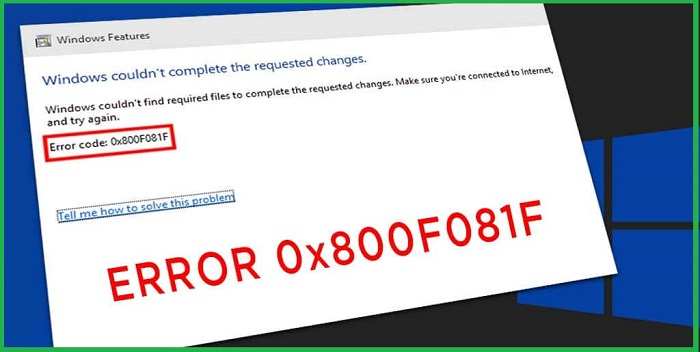This guide will show you how to repair Error Code 0x800F081F in Windows 10. When corrupted files are in your operating system, update error 0X800f081f on Windows 10 frequently occurs. Run System File Checker to resolve Windows update error 0x800f081f. Manually installing the update is an excellent way to resolve error 0x800f081f. You are probably aware that the Windows 10 update is required. That is, at least, what Microsoft wants you to believe. Windows Update usually brings regular updates to other Windows features and routine system stability updates.
The dotNet Framework is one feature that receives relatively regular updates. When you try to update this feature, you may encounter problems loading code 0X800f081f. So, if this is bothering you, we have some solutions and instructions on how to fix Error Code 0x800F081F in Windows 10.
Here are some examples of similar problems encountered by Windows users:
- 0x800f081f Windows Update agent and core – This error may affect other Windows Update components, so it is recommended that you reset all Windows Update components using Command Prompt to resolve the issue.
- .NET 3.5 0x800f081f Windows 10 – If you cannot install updates because of this error, the issue could be with the.NET Framework. Activate the.NET Framework or use the offline.NET installer to resolve the Error Code 0x800F081F issue.
- Error Code 0x800F081F Microsoft Surface Pro 3 – This problem could affect the Surface Pro and other laptop computers. If this is the case, we have prepared a solution that may help you resolve the issue with your laptop, so please try it.
[lwptoc]
How to Fix Error Code 0x800f081f in Windows 10
Here are some suggestions for resolving Error Code 0x800F081F in Windows 10:
1. Use the offline .NET Framework installer
- On the web, look for the most recent offline.NET Framework installer.
- Begin the installation by downloading the installer.
- It may take some time for the files to be ready for installation.
- Follow the instructions and restart the computer once the procedure is finished.
- Check that you are using the official Microsoft version from a trusted source.
2. Use SFC and DISM scan
- To access the Win + X menu, press Windows Key + X.
- Choose Command Prompt (Admin) or Powershell now (Admin).
- Enter sfc /scannow now.
The SFC scan has now begun. Remember that this could take up to 15 minutes, so don’t bother. When the scan is done, check to see if the problem of Error Code 0x800F081Fhas been fixed. If an SFC scan does not resolve the Error Code 0x800F081F issue, or if you cannot run an SFC scan, you may want to try a DISM scan.
Follow these steps to do so:
- First, right-click the Start button and click Command Prompt (Admin).
- Enter the following command at the command prompt:
- DISM.exe /Online /Image-cleanup /Restorehealth
- The second solution can be used if the update service is unavailable. Insert the USB/DVD media containing the system installation files and run the following command (copy-paste):
- DISM.exe /Online /Image-Cleanup /Health-Restore /Source:C:RepairSourceWindows /LimitAccess
- Don’t forget to replace C: RepairSource with the location of your repair source.
- When the process is done, restart your PC and try updating again.
- Check to see if the problem persists after the DISM scan.
If the problem of Error Code 0x800F081F persists or you cannot complete the SFC scan, repeat it now to see if it resolves the issue.
3. Install updates manually
Go to Microsoft’s Update History website and check the update number. (To find missing updates, you can easily compare update history and information on the website.)
You must go to the Microsoft Update Catalog page after you find the updated code, which should begin with KB and be followed by a string of numbers. Enter the update code into the search field to see a results list. (Remember that the list will display updates for various architectures, so select the one that corresponds to your system architecture.) After downloading the update, run the setup file to install it. (Remember, this process will not fix the Error Code 0x800F081F; instead, it will allow you to avoid it and download the update.)
4. Restart the Windows Update component
Run Command Prompt as an administrator.
When Command Prompt appears, enter the following commands, one at a time:
- First, stop bits on the internet.
- Stop appidsvc on the internet.
- Stop cryptsvc on the internet.
- catroot2.bak ren%systemroot%system32catroot2
Net Start components
- wuauserv Net Start
- appidsvc.net Start
- Start cryptsvc on the internet.
- Check to see if the problem has been fixed after running the command.
If you don’t want to run these commands manually, we wrote a quick guide on creating a Windows Update reset script, so be sure to read it and learn how to automate this process. As you may be aware, Windows Update relies on certain services to function correctly, and if any of the services fails, Error Code 0x800F081F is likely to occur.
However, the steps outlined above will restart the Windows Update component and, if necessary, repair any glitches.
5. Ensure that the.NET Framework is on.
- Go to Windows features by pressing the Windows key + S. Turn on or off Windows features.
- The Windows Features dialogue box will now open. First, make sure the.NET Framework 3.5 is turned on. After you’ve enabled it, click OK.
After enabling the.NET Framework, retry the update to see if it works.
6. Use the Windows Update Troubleshooter
Use the Windows Update Troubleshooter to troubleshoot any issues of Error Code 0x800F081F that arise.
- To open the Settings app, press Windows Key + I.
- Open the Settings and navigate to the Update & Security section.
- Now, from the left pane, select Troubleshoot. Next, select Windows Update in the right pane and click Run the Troubleshooter.
- The troubleshooter will now be launched. To finish it, follow the on-screen instructions.
When the troubleshooter is finished, check to see if the Windows Update issue of Error Code 0x800F081F has been fixed.
7. Carry out a clean installation
If you tried the previous ways and they did not work, we recommend that you perform a clean reinstall. That way, you will undoubtedly solve the issue at hand. That is, upgraded systems are far less prone to errors than those installed on a formatted hard drive.
So, back up your files and license key. Then, follow these steps to accomplish it:
- Firstly, make a backup of your files and license key.
- Then, download the Media Creation Tool and install the system using a USB or DVD.
- Connect the bootable source to the affected device once you have it.
- Open the Start Menu, press and hold the Power button, then select Restart from the menu. (Keep in mind that, in some cases, you may need to access the BIOS and change the boot priority settings.)
- A list of points will be displayed. Troubleshooter > Advanced options should be selected.
- Select Startup Repair on the next screen and follow the prompts.
- The device may be rebooted again during the process.
When the procedure is done, you will have a clean installation of Windows 10. It recovers corrupted files and corrects the majority of Error Code 0x800F081F caused by misconfiguration.
ALSO SEE:Fix Error 0x80070643 on Windows 10
Fix 100% Disk Usage in Windows 10
0xC1900101 Error When Installing Windows 10
The Last Word
This guide on fixing the Error Code 0x800F081F windows 10 error should help you overcome mistakes when updating Windows.



